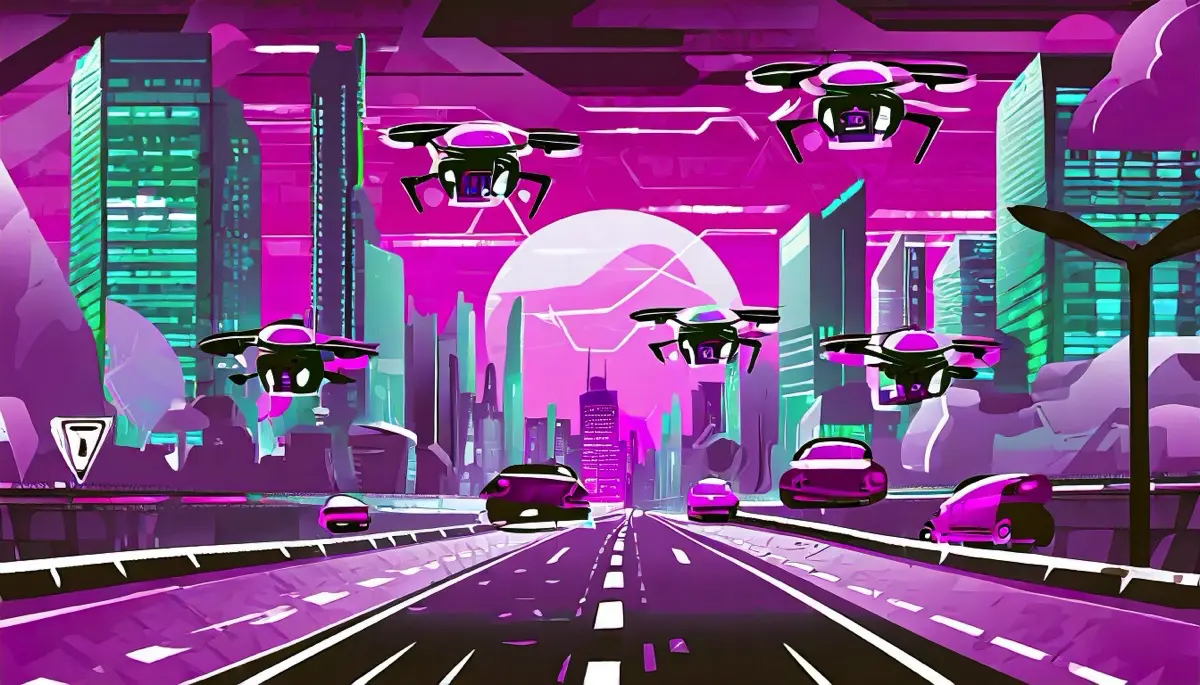
Drones Of The Future: Delivering New Frontiers
I. Introduction to Autonomous Deliveries
In an era of rapidly advancing technology, drones and autonomous delivery robots have captured our imagination. These innovations promise a future where unmanned vehicles handle parcel deliveries with efficiency and speed. Despite the exciting possibilities, the widespread adoption of drones for parcel delivery remains a work in progress.
This blog post explores the landscape of autonomous deliveries, shedding light on the progress and challenges ahead. We delve into the world of delivery drones, examining their innovative technologies, potential benefits, and limitations. We also discuss real-world success stories, such as medical supply deliveries to remote areas and parcel deliveries by industry giants like Amazon and Google.
Additionally, we investigate the regulatory framework governing autonomous delivery systems in different countries, focusing on their efforts to ensure safe and responsible deployment. Moreover, we uncover the technical challenges that engineers and developers are actively addressing to make autonomous drone and robot deliveries a reality, from improving battery technology to enhancing navigation in diverse conditions.
Join us on this journey through the complex terrain of autonomous deliveries, where innovation meets regulation, and technology advances in the pursuit of transforming how we receive our packages. The future of deliveries is closer than we think, and this post explores the steps required to turn that vision into a tangible reality.
II. Delivery Drones: Innovation and fulfilment
Delivery drones are unmanned aerial vehicles (UAVs) designed for transporting packages. Drones utilise various mechanisms for flight, such as propellers, wings, or rotors, allowing them to fly vertically or horizontally. They can deliver or retrieve packages using parachutes or landing pads and rely on remote control or autonomous navigation systems to follow predefined routes or dynamic algorithms.
Delivery drones offer several advantages over conventional delivery methods, including:
- Swift access to remote or inaccessible areas compared to ground vehicles.
- Reduced road congestion and pollution due to their electric power source.
- Enhanced efficiency and reliability by avoiding traffic delays and human errors.
- Improved customer experience through faster delivery times and real-time tracking.
However, they also face certain challenges and limitations, such as:
- limited payload capacity,
- battery life,
- the need for complex technology and infrastructure,
- regulatory approval, and
- Concerns about privacy, theft and property damage.
Numerous companies are actively vying for market share in this field. The following section highlights some notable successes in the industry.
1.1 Medical Supplies
Zipline - delivering medicine, blood and other medical supplies in remote areas
The delivery of medical supplies to remote areas has been a compelling use case for drones. Companies like Zipline have excelled in this domain, providing life-saving deliveries to regions with limited access to healthcare resources. Zipline, for instance, delivers a significant portion of Rwanda's blood supply outside the capital, Kigali. In 2022, Zipline achieved FAA Part 135 approval for long-range delivery drones in the U.S., marking a significant milestone in the industry.
According to a number of publications in 2022, Zipline's service achieved the following impact:
- A reduction of 67% in blood wastage across Rwanda (published in The Lancet);
- 60% shorter vaccine stockouts as compared to non-Zipline services (Bill and Melinda Gates Foundation);
- An 88% reduction of in-hospital maternal deaths due to postpartum haemorrhage (Wharton university)

Platform: Fixed-wing
Range: 120+ miles round trip
Delivery Mechanism: Parachute from 60-80 ft above ground level
Payload: 4 pounds
Operational Areas: Rwanda, Ghana, U.S. , Nigeria, Japan, Kenya, Cote D'Ivoire.
Founded in: 2014
Skyports - The first operator to bring drone deliveries in the U.K.
Skyports, a UK-based company, pioneered drone deliveries in the United Kingdom by transporting test samples, PPE, and COVID-19 tests between Mull, Iona, and Oban, Scotland. They received permission from the UK Civil Aviation Authority (CAA) to carry diagnostic specimens by drone.
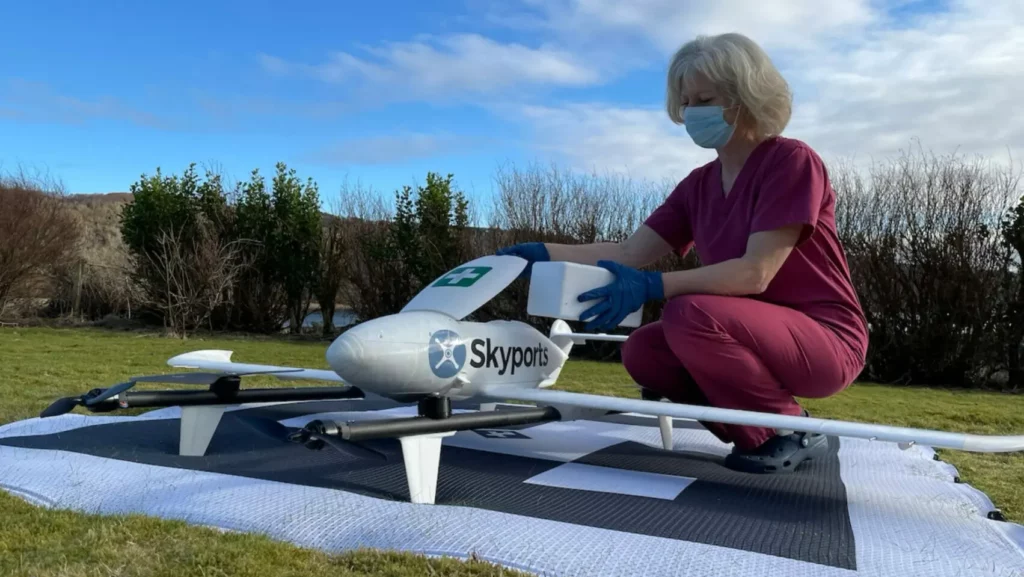
Platform: Multi-Rotor VTOL Transition
Range: 120+ miles round trip
Delivery Mechanism: Parachute from 60-80 ft above ground level
Payload: 4 pounds
Operational Areas: U.K.
Founded in: 2018
Swoop Aero - Creating versatile drones to help with essential deliveries in remote areas
Swoop Aero, an Australian company founded in 2017, specialises in developing and operating drone-based logistics solutions for healthcare and other industries. They have gained recognition for delivering medical supplies, vaccines, and healthcare services to remote communities.
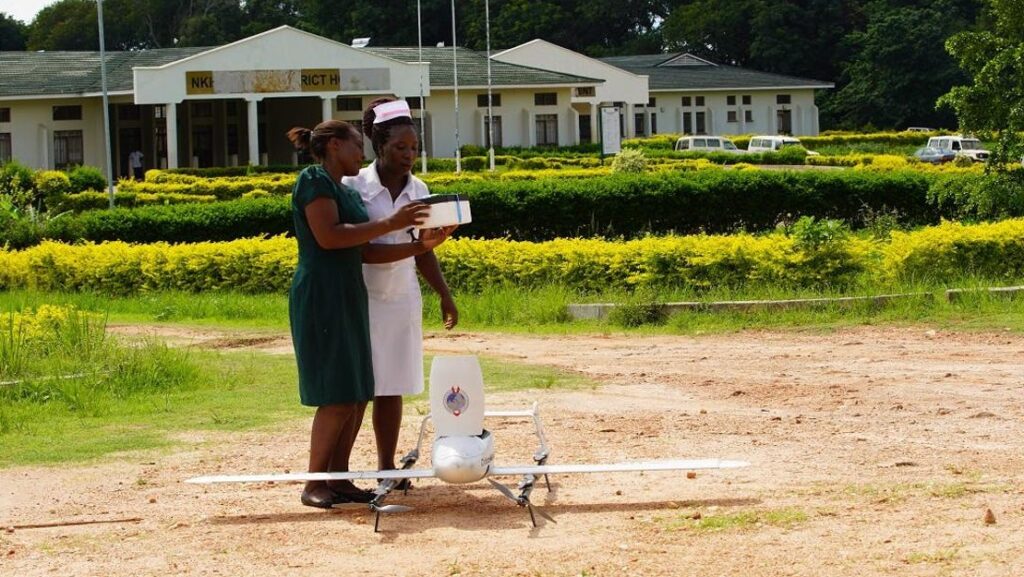
Platform: Multi-Rotor VTOL Transition
Range: 108+ miles round trip
Delivery Mechanism: Ground Level
Payload: 6.6 pounds
Operational Areas: Albania, Malawi, Singapore, Ethiopia, the Democratic Republic of Congo, Mozambique, Eswatini and Australia
Founded in: 2017
1.2 Parcel Deliveries
Last-mile delivery accounts for over 50% of total delivery costs and contributes to global CO2 emissions. Companies like Amazon, UPS, and Google have embarked on innovations in autonomous drone parcel delivery systems to address these challenges.
Amazon Prime Air - MK30 - A heavy lift fast delivery drone
Amazon Prime Air unveiled the MK30 drone, equipped with "sense and avoid" technology for obstacle detection. These drones can carry packages up to five pounds and operate in various weather conditions, making one-hour or less deliveries.

Platform: Multi-Rotor VTOL transition
Range: Unspecified
Delivery Mechanism: Ground Level
Payload: 5 pounds
Operational Areas: Not operational yet
Scheduled to operate in the U.K, U.S and Italy in 2024
Founded in: 2013
Google Wing - A drone delivery system built with safety in mind
Google's Wing project, now known as Wing, focuses on safety through redundancy, with multiple rotors, batteries, and navigation systems. The tether system disengages upon reaching the ground, eliminating the need for recipient interaction.

Platform: Multi-Rotor VTOL Transition
Range: 12 miles round trip
Delivery Mechanism: Tether
Payload: 2.6 pounds
Operational Areas: Australia, U.S, Finland and Ireland
Founded in: 2012
Matternet - Delivering medical supplies in urban areas and parcels
Matternet, authorised for commercial Beyond Visual Line of Sight (BVLOS) operations in Switzerland, partnered with UPS to launch drone delivery services in the U.S. Their M2 drone achieved Type Certification and Production Certification by the Federal Aviation Administration (FAA) in 2022.
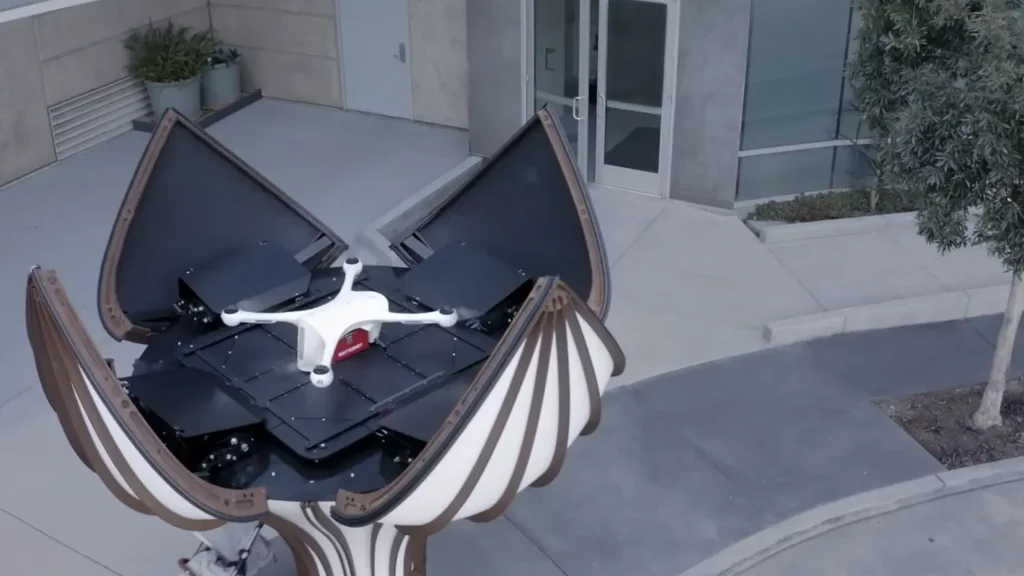
Platform: Multi Rotor
Range: 108+ miles round trip
Delivery Mechanism: Proprietary pod
Payload: 4.4 pounds
Operational Areas: Switzerland, U.S.
Founded in: 2011
Flytrex - The suburban food delivery drone
Flytrex operates autonomous drone systems in Texas and North Carolina, primarily for food deliveries in suburban areas. Their drones feature safety mechanisms like lidar units for obstacle detection.
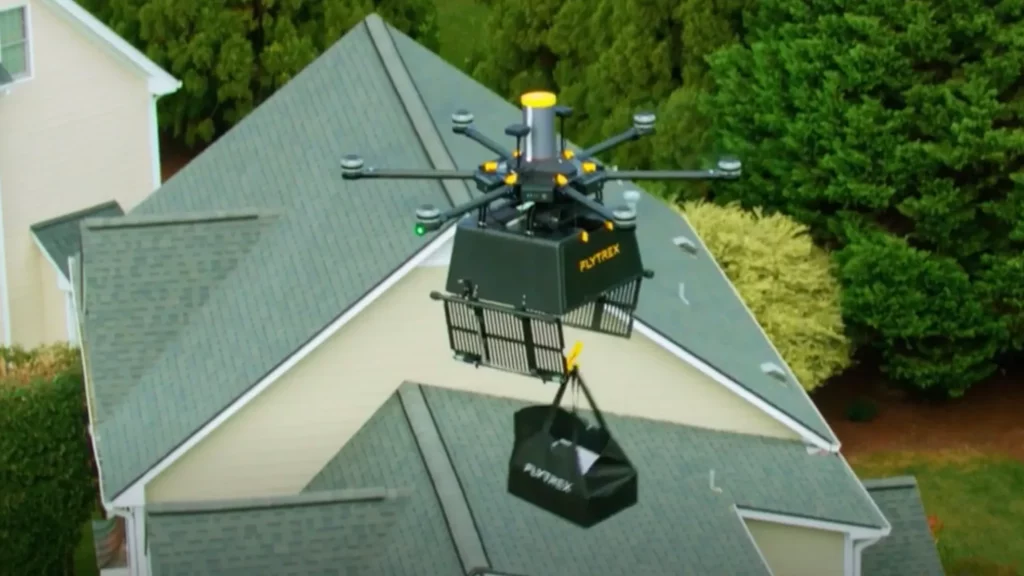
Platform: Multi Rotor
Range: 5 mile round trip
Delivery Mechanism: Ground Level
Payload: 5.5 pounds
Operational Areas: U.S.
Founded in: 2013
III. Delivery Drones: Regulatory Framework
The UK has pioneered developing and testing delivery robots and drones, establishing a supportive regulatory environment for their safe use. The Civil Aviation Authority (CAA) serves as the primary drone regulator and has introduced regulations based on the EU's UAS Regulations, categorising drones into Open, Specific, and Certified categories.
3.1: The UK's Approach: CAA Drone Rules and Regulations Overview
The Open category covers low-risk drone flights that do not require prior authorisation or operational declaration but must follow certain limitations, such as maximum weight, height, distance, and speed.
The Specific category covers medium-risk drone flights that require operational authorisation from the CAA based on a risk assessment. This is the category that fits autonomous delivery drones.
The Certified category covers high-risk drone flights that require a certification of the drone, the operator, and the pilot, similar to manned aviation.

CAA helping innovators get off the ground
The CAA also runs several innovation programmes to facilitate the development and testing of new drone technologies and applications, such as the Innovation Sandbox and the Future Flight Challenge. These programmes provide a safe and flexible environment for drone operators to trial new concepts and solutions, such as beyond visual line of sight (BVLOS) operations, urban air mobility (UAM), and drone delivery services.
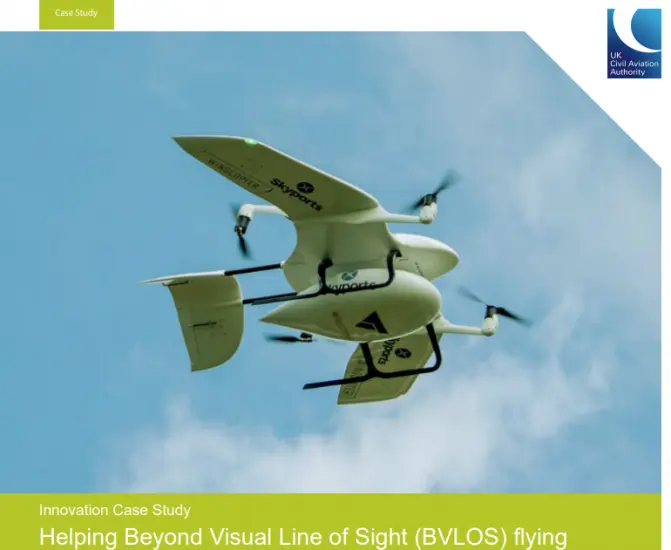
3.2 Drone Regulations in Other Countries
Other countries have also been developing their own regulatory frameworks for delivery robots and drones, with varying degrees of progress and complexity. For example:
USA
In the US, the Federal Aviation Administration (FAA) regulates drone operations under Part 107 of the Federal Aviation Regulations (FARs), which sets out the requirements and limitations for commercial drone operators. However, some advanced drone operations, such as BVLOS or over people, require a waiver or exemption from the FAA. The FAA also runs several programmes to support drone innovation and integration into the national airspace system (NAS), such as the Unmanned Aircraft System (UAS) Integration Pilot Program (IPP) and the UAS Traffic Management (UTM) Pilot Program.
China
In China, the Civil Aviation Administration of China (CAAC) regulates drone operations under several regulations and standards, such as the Regulations on Management of General Aviation Flight Activities (2016), which defines drones as general aviation aircraft. The CAAC also issues licenses and permits for drone operators based on their type and purpose of operation. China has been a global leader in drone delivery services, with companies such as JD.com and SF Express conducting millions nationwide deliveries.
Australia
In Australia, the Civil Aviation Safety Authority (CASA) regulates drone operations under Part 101 of the Civil Aviation Safety Regulations (CASRs), which sets out the rules and requirements for different types of drone operators, such as recreational, commercial, or excluded. The CASA also runs several programmes to facilitate drone innovation and integration into the Australian airspace system, such as the RPAS Digital Platform and the Emerging Aviation Technology Partnerships. There is no national regulation for delivery robots, but some states have issued permits or exemptions for their use on public roads.
IV. Delivery Drones: Technical Challenges and Limitations
As the world eagerly anticipates the future of autonomous drone deliveries, it must recognise that while this technology holds great promise, it also faces several significant technical challenges and limitations. In this section, we'll delve into some of the critical hurdles engineers and developers are working to overcome to make drone deliveries a reality.
4.1. Battery Technology
One of the most pressing challenges in the realm of drone deliveries is battery technology. While drones have made substantial strides in energy efficiency, battery capacity, and overall flight time, there's still room for improvement. The limitations of current lithium-ion battery technology mean that drones typically have relatively short flight times compared to their ground-based counterparts.
The need for extended flight durations becomes evident when considering long-distance deliveries or covering vast urban areas. Researchers are actively exploring alternative energy storage solutions, such as hydrogen fuel cells and advanced battery chemistries, to address this. These innovations boost drone endurance, making deliveries more practical and cost-effective.
Drone batteries currently use Lithium Ion (Li-Ion) or Lithium Polymer (Li-Po) technologies. One particular feature of these batteries is that they degrade with time, and eventually, they reach a point of instability where the fire is a real risk. Many hobbyist houses have been burnt down by old Li-Po batteries that self-ignited. In addition, lithium batteries generate oxygen, which makes the fire almost impossible to extinguish fully.

A potential solution for the problems imposed by Li-Ion and Li-Po is to use solid-state batteries. Solid-state battery technology offers several advantages over traditional lithium-polymer (Li-Po) batteries.
Firstly, solid-state batteries are safer due to their reduced risk of thermal runaway and fire, as they don't contain flammable liquid electrolytes.
Secondly, they have the potential for higher energy density, which means they can store more energy in a smaller and lighter package, leading to longer-lasting and more efficient power sources for various applications, including drones and electric vehicles.
Additionally, solid-state batteries tend to have longer lifespans and improved cycle durability, making them more cost-effective in the long run. These advantages make solid-state batteries a promising technology for various electronic devices and transportation solutions.

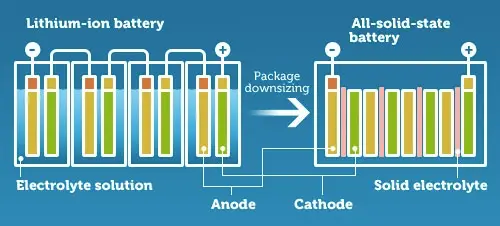
4.2. GPS Signal Loss
Drones rely heavily on Global Positioning System (GPS) signals for navigation and precise location tracking. However, GPS signals can be susceptible to interference and loss, particularly when flying in urban canyons or densely wooded areas. This can lead to inaccurate positioning and potentially hazardous situations for drones during deliveries.
To mitigate this issue, drone developers are exploring additional navigation and localisation technologies, including computer vision, radar, and LiDAR. These complementary systems can help drones maintain their course and avoid obstacles even when GPS signals are unreliable.
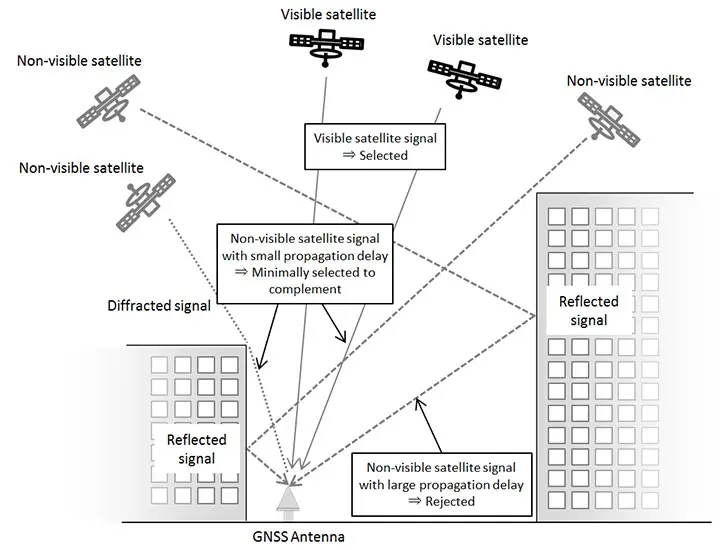
4.3. Sensors and Autonomous Flights
Autonomous flight is at the heart of drone deliveries, allowing them to navigate complex environments and reach their destinations safely. Achieving a high level of autonomy requires advanced sensors and sophisticated algorithms. While drones equipped with sensors like ultrasonic, infrared, and LiDAR can perceive their surroundings to a certain extent, there are limitations to their capabilities.
One challenge is the detection and avoidance of moving objects, such as birds, other drones, or even humans, in real-time. Ensuring collision avoidance and safe navigation in dynamic environments remains a technical hurdle. Developers are continually improving object recognition algorithms and sensor integration to enhance drone autonomy further.
Moreover, maintaining safe flight paths in unpredictable weather conditions is another challenge. Wind, rain, and fog can all affect a drone's stability and navigation, requiring robust flight control systems and AI-driven decision-making to adapt to changing circumstances.
Ai vision system improvements show promising results in helping overcome this technical challenge. One example is the case of the University of Zurich AI called Swift, which has outperformed human pilots around a drone racing track.

V. Delivery Robots: Rolling on the Pavements
We spoke about the advantages and disadvantages of delivery drones. And at this point, you might be thinking. What about those robots roaming the streets?
Delivery robots are small, wheeled vehicles that can carry packages on pavements, bike lanes, or pedestrian zones. They use cameras, sensors, GPS, and artificial intelligence to navigate their environment and avoid obstacles. They can also communicate with customers via smartphone apps or speakers to confirm delivery details and unlock the cargo compartment.
Some of the major players in this market are:
These companies have been testing and deploying their robots in various cities worldwide, delivering food, groceries, medicine, and other items.
5.1 Examples of Delivery Robots Use Cases
- Starship Technologies has partnered with universities in the US and UK to deliver food to students and staff on campus.
- Nuro has partnered with Kroger and Domino’s to offer groceries and pizzas in Houston.
- FedEx Roxo has shown packages in several US cities, including New York, Los Angeles, and Memphis.
5.2 Advantages of Delivery Robots
Delivery robots have several advantages over traditional delivery methods, such as:
- 24/7 operations,
- reduced traffic congestion and emissions,
- lower labour costs and human errors,
- And increase customer convenience and satisfaction.
5.3 Challenges and Limitations
However, they also face some challenges and limitations, like:
- limited range and speed,
- require adequate infrastructure and regulation,
- need human supervision and intervention in some cases, and
- may encounter theft, vandalism, or accidents.
Delivery robots have yet to prove to be all their makers dreamt of. FedEx is stopping development on their last-mile delivery robot, Roxo. The news was first reported by Robotics 24/7, with FedEx confirming to the publication that the company would be shifting focus away from the bot to more “nearer-term opportunities.”
FedEx isn’t the only major U.S. company re-evaluating its robotic delivery efforts. Amazon has also decided to scale back its Scout automated delivery program. In a statement shared with The Verge, Amazon spokesperson Alisa Carroll said the company is ending field testing of Scout but will continue to have a team dedicated to its development.
In a statement offered to TechCrunch, Amazon notes the company isn’t killing the robot altogether but is instead scaling back the program. This is still a dramatic setback for the program, not to mention the 400 or so humans working on it. How small the new team will ultimately be remains to be seen.
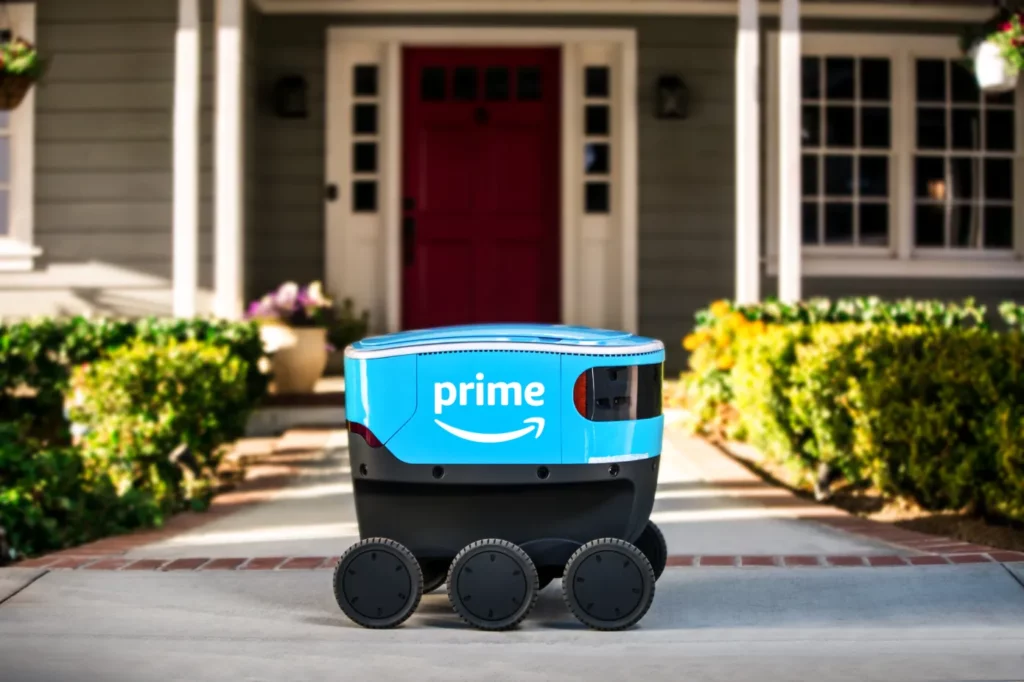
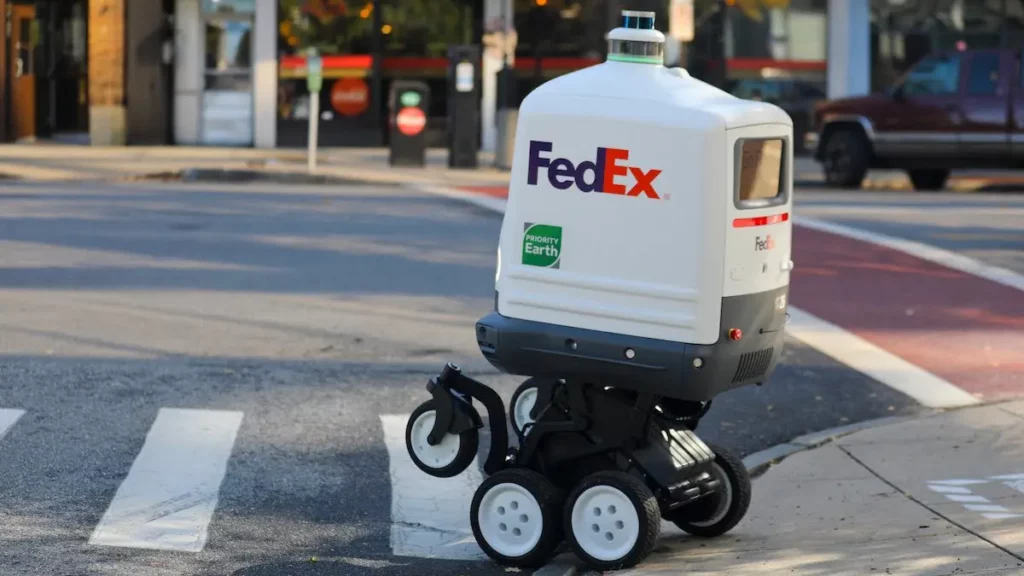

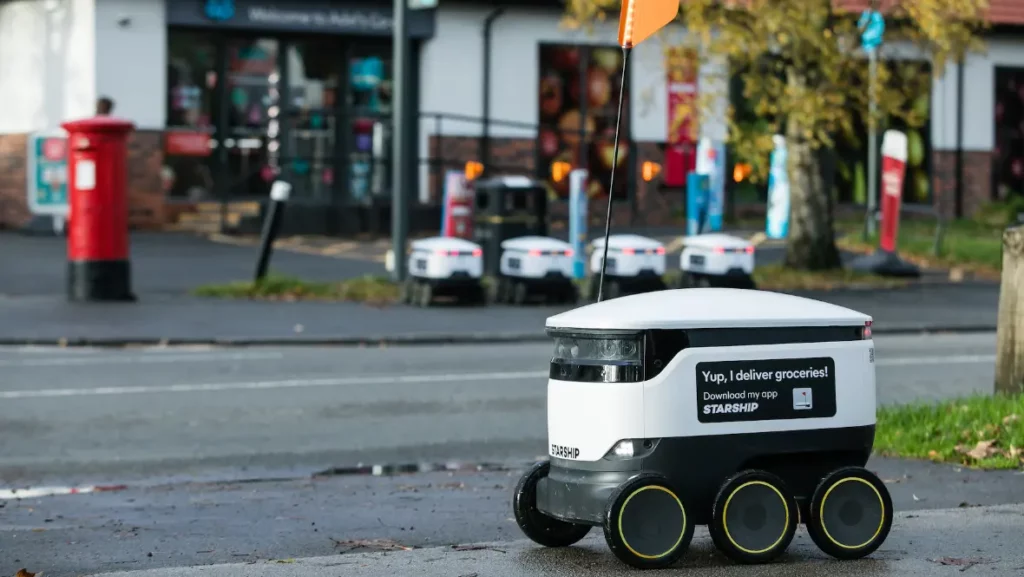
VI. Conclusion
In conclusion, the world of autonomous drone and delivery robot technology is progressing excitingly, bringing us closer to the futuristic vision of efficient, fast, and environmentally friendly parcel deliveries. As we've explored in this post, there have been remarkable success stories in medical supply deliveries, where companies like Zipline have made life-saving contributions by reaching remote areas with essential supplies.
6.1 Parcel Deliveries
Moreover, when it comes to parcel deliveries, major players like Amazon, Google, and others have made significant strides in developing fully autonomous systems that can potentially revolutionise the last-mile delivery process. These innovations aim to reduce emissions, traffic congestion, and delivery costs while enhancing customer convenience.
6.2 Regulatory Frameworks
However, as with any emerging technology, regulatory challenges exist. Different countries are developing their regulatory frameworks to ensure the safe and responsible use of delivery drones and robots. These frameworks, like the ones set by the UK's Civil Aviation Authority (CAA), provide guidance on risk classification, operational limitations, and innovation support.
4.2 Technical Challenges
Technical hurdles, such as improving battery technology to extend flight times and enhancing navigation systems to overcome GPS signal loss and ensure safe, autonomous flights, remain. Innovations like solid-state batteries and alternative navigation technologies offer promising solutions to these challenges.
6.3 Advantages and Disatvantages
Additionally, the world of delivery robots presents its own set of advantages and challenges. While they offer 24/7 operations, reduced traffic congestion, and increased convenience, they still grapple with limited range and speed, the need for infrastructure and regulation, and occasional human supervision.
In recent developments, we've seen some major companies like FedEx and Amazon recalibrating their efforts in the delivery robot space, emphasizing the need for practical, near-term solutions while maintaining their commitment to further development.
6.4 Looking towards the future
In the grand scheme of things, the future of autonomous parcel deliveries remains bright, with continued innovation and collaboration between industry players, regulatory bodies, and technology enthusiasts. As we move forward, it's exciting to imagine a world where drones and delivery robots play a vital role in transforming how we receive goods, making our lives more efficient, convenient, and sustainable.
If you are interested in drone delivery and want to work on it yourself, these companies are currently hiring: Skyports Careers
If you would like to get started with building drones, you can find a great entry-level tutorial here: Oscar Liang: how to build an FPV drone
References:
- builtin.com
- Swift Ai FPV
- clean-mobility.org
- https://www.robotics247.com/company/flytrex
- prnewswire
- tech-crunch
- flyzipline.com
- expertmarketresearch.com
- mckinsey.com
- wired.co.uk
- starterstory.com
- aerosociety.com
- techradar.com
- eandt.theiet.org
- hansard.parliament.uk
- drone-laws.com
- gov.uk
- bbc.co.uk
- assets.publishing.service.gov.uk
- bbc.com
- thespoon.tech
